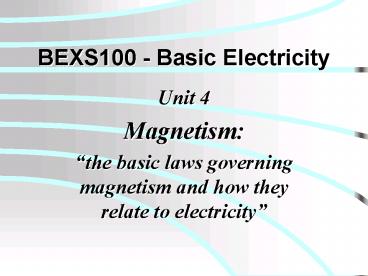BEXS100 Basic Electricity - PowerPoint PPT Presentation
1 / 22
Title:
BEXS100 Basic Electricity
Description:
The 3 different systems used to measure the strength of a magnetic field: Magnetic Polarity ... Transformers. Motors. Generators;Alternators ... – PowerPoint PPT presentation
Number of Views:29
Avg rating:3.0/5.0
Title: BEXS100 Basic Electricity
1
BEXS100 - Basic Electricity
- Unit 4
- Magnetism
- the basic laws governing magnetism and how they
relate to electricity
2
Objectives
At the completion of this unit you will be able
to
- Understand the properties of permanent magnets
- Understand the operation of electromagnets
- Determine the polarity of an electromagnet
- Define terms used to describe magnetism and
magnetic quantities
3
Introduction to Magnetism
- One of the most important phenomena in the study
of electricity - The force of magnetism has been known for over
2000 years (Greeks) - Stones with magnetic qualities (magnetite) were
first found in Magnesia in Asia Minor - In the Dark Ages magnetism was thought to be
caused by evil spirits
4
Electromagnetics
Terms to remember
- Permeability - a measure of a materials
willingness to become magnetized - Reluctance - a materials resistance to magnetism
- Saturation - the point when an increase in
current fails to significantly increase the
magnetic field - Residual Magnetism - the amount of magnetism left
once current flow has stopped
5
The Earth is a Magnet
- Geographic poles vs. magnetic poles
- lodestones
- Angle of declination
6
THE FIRST COMPASS
7
Permanent Magnets
Magnets that do not require any power or force to
maintain their field
One of the basic laws of magnetism states
Energy is required to create a magnetic field,
but no energy is required to maintain a magnetic
field
8
The Electron Theory of Magnetism
What makes materials such as iron, nickel, or
cobalt, a natural magnetic material
- Electron spin theory
- Electrons become tiny permanent magnets
- Electrons in most materials spin in opposite
directions - Once paired they tend to cancel out any
magnetic properties
9
The Electron Theory of Magnetism
What makes materials like iron different than
most materials
- An Atom of iron contains 26 electrons
- 22 of the electrons are paired and cancel each
other out - The remaining 4 electrons located in the next to
the outermost shell do not become paired and
spin in the same direction - These 4 electrons account for the magnetic
properties of iron
10
The Electron Theory of Magnetism
What makes materials like iron different than
most materials
- As atoms combine to form molecules
- They arrange themselves to form a total of 8
valence electrons - In most materials the electrons cancel each other
out - In materials such as iron, the magnetic fields
add rather than cancel - This additive effect forms regions in the
molecular structure of the metal called
Magnetic Domains or Magnetic Molecules
11
Magnetic Domains/Molecules
12
Magnetic Materials
The three basic classifications
- Ferromagnetic - metals that are easily
magnetized iron, nickel, cobalt, manganese - Paramagnetic - metals that can be magnetized but
not as easily as ferromagnetic
platinum,titanium,and chromium - Diamagnetic - metal or non-metallic materials
that cannot be magnetized copper,brass, and
antimony
Note Alloys often make the best permanent magnet
materials. Combinations of such metals as
aluminum, nickel, cobalt, copper, and iron
(Alnico 5) are commonly used in the production of
permanent magnets
13
Magnetic Lines of Force
- Magnetic lines of force are called flux
- Magnetic lines of flux repel each other never
cross - Lines of flux do not flow but it is assumed
that they run North to South
One of the basic laws of magnetism Unlike poles
attract - Like poles repel
14
Electromagnetics
A basic law of physics Whenever an electric
current flows through a conductor, a magnetic
field is formed around the conductor
- Electromagnets depend on electrical current flow
- They do not retain their magnetic field once
current flow stops
15
Electromagnetics
Factors that effect electromagnetic fields
- Winding the conductor into a coil increases the
strength of the magnetic field - A coil with 10 turns of wire will increase the
magnetic field around the conductor by 10 - The strength of the magnetic field is
proportional to the amount of current flowing
through the conductor
Ampere-Turns is determined by multiplying
the number of turns of wire by the current flow
16
Electromagnetics
Core Materials magnetic/non-magnetic materials
around which the conductor is coiled
Two Types
- Air core electromagnets
- Core is made of Non-magnetic material
- Iron core electromagnets
- Made of magnetic materials
- Greatly increases strength of the magnetic field
by increasing the number of flux lines
17
Magnetic Measurement
The 3 different systems used to measure the
strength of a magnetic field
- The English System - flux density
- The CGS System - centimeter-gram-second
- The MKS System - meter-kilogram-second
18
Magnetic Polarity
Determining the Polarity of an Electromagnet
- The Left-Hand Rule
19
Demagnetizing
Disarranging molecules in a magnetic material
20
Magnetic Devices
- Electromagnets
- Measuring instruments
- Inductors
- Transformers
- Motors
- GeneratorsAlternators
A Speaker uses both a permanent magnet and an
electromagnet
21
Summary
- Energy is required to create a magnetic field,
but no energy is required to maintain a magnetic
field - Unlike poles attract, like poles repel
- Whenever current flows through a conductor a
magnetic field is formed around the conductor - The direction of current flow through a conductor
determines the polarity of the magnetic field
22
Elizabethtown Technical College Basic Electricity
BEXS100/101 Text Delmars Standard Textbook of
Electricity Unit 4 - Magnetism































